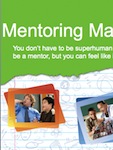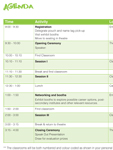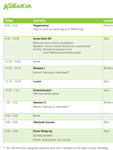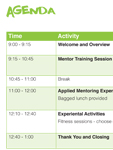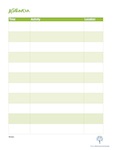Step 2: Setting the Agenda
No two training events are the same. How you choose to structure the day will depend largely on the resources and goals you identified in Step 1.
Select the format, activities and sessions that best meet the needs of your organization and support your desired outcomes.
Overview
Training can be a half-day or full-day event. Every participant needs to attend a Mentor Training Session but beyond that you are limited only by your imagination!
As you read through the following sections, use this agenda template to start sketching out an outline of the day. Check out the sample agendas to help you get started.
Mentor TrainingEvery potential mentor must participate in the Mentor Training Session. The session takes approximately 1.5 or 2 hours to deliver, depending on group size, and provides guidelines for working with mentees, including communication skills, sharing information, confidentiality, reporting abuse, appropriate roles, and activities.
Types of Sessions
There are three main categories outlined here - click on each category for examples, session descriptions and resources where available.
- attended by all participants
- typically in the main hall or group gathering area
- opportunity to ensure all participants hear the same message
- held in breakout rooms or in round-table format
- participation in smaller groups allows for discussion and interaction
- participants develop specific skills and learn about one or two topics
- can be held in main hall or breakout rooms
- can involve all conference attendees simultaneously or in subsets
- gives participants an opportunity to apply the skills they have learned, either directly or indirectly
Breaks:
Unstructured times between sessions for participants to unwind, engage in informal networking, and form relationships and connections. Morning and afternoon breaks are a perfect time to provide snacks and beverages, while lunch break, or immediately after, is an excellent time to incorporate some form of short entertainment such as a dance group or local band.
Click here to access session resources & examples
TIPS FROM THE TRENCHES
Lecture-style presentations can be boring and difficult for both the participants and presenter. Deliver training in ways that keep participants interested and engaged
- use a variety of information-sharing methods including short PowerPoints, online clips, games and handouts
- get participants involved in group discussions and problem solving where they can practice what they have learned
- in longer sessions, incorporate activity breaks that get people out of their chairs and moving - increased blood flow helps with concentration
Consider holding a resource fair to provide mentors access to supplementary information:
- invite representatives from government, local organizations or post-secondary schools
- incorporate ½-an-hour into the day for participants to visit the booths, or hold the resource fair during lunch
Participants most frequently identify the following as their favorite things about the day:
- speakers and entertainment
- the food
- meeting new people, including staff from the mentoring organizations
- presentations and information about mentoring (Mentor Training session)
- teamwork activities
- the variety of events
- getting to spend time mentoring a younger student
- learning by doing something fun

